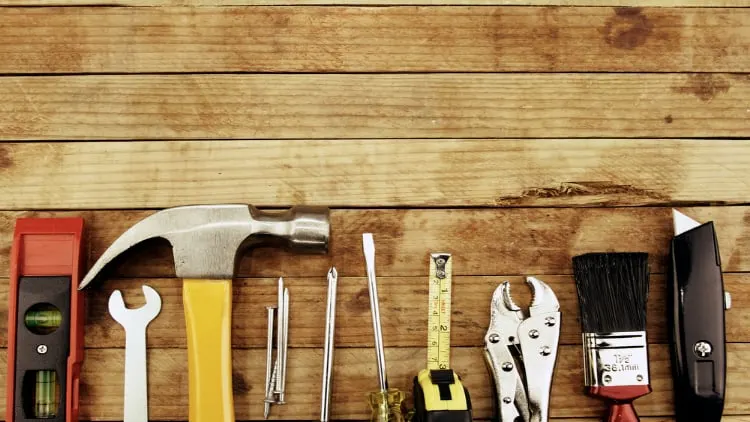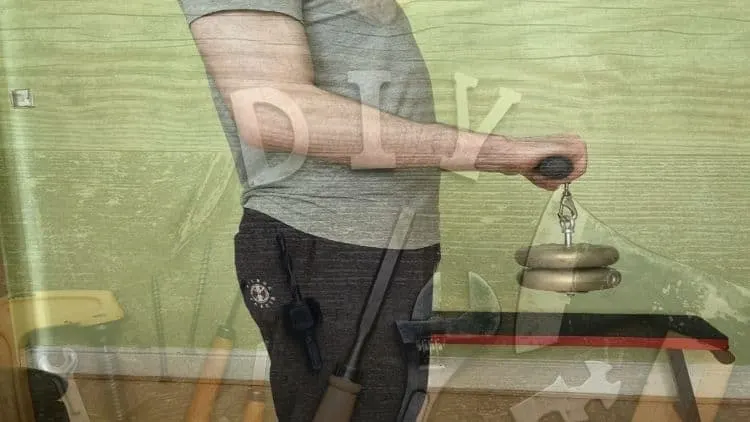The wrist roller is one of the most effective exercises for training the forearm flexors and extensors—especially if you like to train at home.
And while it’s possible to just buy the best wrist roller on the market and get on with lifting, there’s something incredibly satisfying about building gym equipment with your hands.
Admittedly, making a homemade wrist roller isn’t the most groundbreaking task. But if you’ve never made DIY fitness equipment before, learning how to make your own wrist roller will be deeply satisfying.
What do you need to make a wrist roller?
There are multiple ways to make a DIY wrist roller. However, in each case, you’ll need similar tools.
- Wooden or PVC piping
- Tape measure
- Marker pen
- Skipping rope cable or string
- Carabiner clip
- Weight plate(s)
- Electric drill
You can use either PVC piping or wood. You could even use metal if you like. The only requirement is that the material is at least somewhat thick so that you can easily grip it with your hands.
The tape measure is so that you know how much wood or PVC piping to use and also so that you know where to drill the hole, i.e., centrally.
As for the cabling, you can either use the wire from a jump rope or some sturdy string. Alternatively, you can use a dedicated cable pulley (a bit like they have on gym machines), but these cost more and kind of defeat the purpose of this being an affordable DIY project.
The carabiner isn’t 100% necessary because you can just loop one end of the rope wiring or string around the piping to secure the weight.
Finally, you’ll need a drill to make a hole in the center of the piping. Try and measure this to be exactly in the middle, if you can, so that the wrist roller doesn’t flop to one side during use (this could eventually cause muscle imbalances).

How to make a wrist roller properly
- Cut a 50-60cm section of PVC piping.
- Use a tape measure to find the center of the piping and mark this spot with a pen.
- Drill 2 holes—right next to each other—as close to the center point as possible.
- Remove the ends of your skipping rope so that you’re just left with the cabling.
- Loop the cable ends through their respective holes and then out of the ends of the PVC (each end of the rope should come out of a different end of the piping).
- Place the ends of the skipping rope that you just removed back into the ends of the cabling*. This prevents the rope from going back through the hole.
- You now have a finished wrist roller.
- To attach the weights, loop the cabling through the hole in the center of your weight disc.
- Then, loop the piping through the same hole in the bottom of the cabling and pull it through.
*If your skipping rope doesn’t have those ends, then you can simply tie it into a different object in order to stop the rope from going back through the hole.
What are the benefits of making a DIY wrist roller?
Learning how to make a wrist roller is immensely rewarding. But there are other benefits, too.
Deep satisfaction
Food tastes better when you produce it yourself. Likewise, you also appreciate gym equipment more when you create it yourself.
Sure, it might not have all the bells and whistles of these modern gym machines, but something simple like a DIY wrist roller makes you get better by sticking to the basics rather than looking for the next fitness fad.
Plus, making stuff with your hands always gets the testosterone pumping.
Complete customization
While there are decent rollers available like the Rogue Wrist Roller and the Grip Freak Hanging Wrist Roller, when you make one yourself, you can completely customize every aspect of it.
If you want to create a cool homemade wrist roller from wood, then you can do that. If you want to make an indestructible metal roller, then you can do that too.
You can even start making your own wrist rollers and then selling them to people if you like. Some lifters are pretty lazy these days and would rather have the service done for them (or maybe they just like homemade equipment). Plus, I think it’s actually a pretty clever business idea.
Saves you money
A decent drill might cost a few quid, but the rest of the equipment that you need to make wrist roller equipment is very affordable. And who knows, you might already have it lying around the house.
Are there any downsides to using a homemade wrist roller?
For me, learning how to make a forearm wrist roller has no negatives. After all, if you buy a wrist roller from the shops or online, it was still made by something. So why not let that something be your hands?
Of course, it’s possible to make mistakes when learning how to make a wrist roller properly. But if you follow the instructions and watch a few videos, then the project isn’t too challenging.
And even if it takes you a few attempts, it doesn’t matter because most people don’t work with their hands anyway, so you’re definitely more skilled than most for even attempting the project.
Yet, if you just want to get on with training, then you can check out these reviews of proven forearm products for some more ideas.
- Vikingstrength Forearm Blaster
- GD Wrist Roller
- Pellor Wrist Roller
- Sidewinder Grip Twister
- Sidewinder Pro Xtreme
- Sidewinder Pro Plus
- Ironmind Twist Yo Wrist
- Ironmind One Wicked Wrist Roller
- Sidewinder Revolution
- Bison 1
Conclusion: Is making a homemade wrist roller worth the effort?
Overall, I highly recommend creating a homemade wrist roller if you like making your own creations with your hands and also enjoy gym training.
You will no longer need to live in a commercial gym when you have a DIY wrist roller because you can train your forearms just about anywhere.
I hope that you found this tutorial useful. I’d like to thank the 9to5Strength YouTube channel and Max Sandberg for the helpful videos. Both of the videos are linked above for your viewing pleasure, and I definitely recommend checking them out. Thanks for reading.
References
- Stiggins, C., & Allsen, P. (1986). EXERCISE METHODS: Wrist Roller. National Strength and Conditioning Association Journal, 8(1), 81–82. https://journals.lww.com/nsca-scj/Citation/1986/02000/EXERCISE_METHODS__Wrist_Roller.17.aspx
- French, S. (2020, April 20). How to DIY Your Own Dumbbells, Weights, and More for Home Workouts. Wirecutter: Reviews for the Real World. https://www.nytimes.com/wirecutter/blog/diy-home-workout-equipment/
- 9to5Strength. (2017, March 3). How to Make A Forearm Wrist Roller – Forearm Training [Video]. YouTube. https://www.youtube.com/watch?v=0zYnVqJuMv0
- Max Sandberg. (2019, August 5). How to Make a Homemade Forearm Trainer [Video]. YouTube. https://www.youtube.com/watch?v=UHIkbz8c98I

